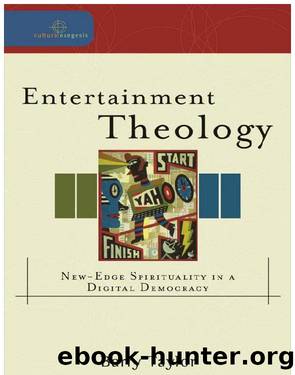Entertainment Theology by Barry Taylor

Author:Barry Taylor
Language: eng
Format: epub
Tags: ebook, book
Publisher: Baker Publishing Group
Published: 2008-03-01T00:00:00+00:00
Retrolution: Postmodern Gothic
Life is something unfathomable, ever-changing, mysterious, and every attempt to confine it within an artificial, abstract structure inevitably ends up homogenizing, regimenting, standardizing and destroying life, as well as curtailing everything that projects beyond, overflows, or falls outside the abstract project. What is a concentration camp, after all, but an attempt by utopians to dispose of those elements which do not fit in?
Vaclav Havel, On Evasive Thinking
God is nowhere, God is now here.
God is now here, God is nowhere.
Douglas Coupland, Hey Nostradamus
Darkness has more Divinity for me,
It strikes thought inward, it drives back the soul
To settle on Herself, our Point supreme.
Edward Young, Night Thoughts
Seventeen million people have read Dan Brownâs The Da Vinci Code,68 a tale of murder, mystery, and intrigue, in the first two years of its publication and millions more have seen the movie. It is the story of an American symbologist, Robert Langdon, who while on holiday in Paris is summoned to the Louvre late at night for a meeting with the curator of the museum. Upon arrival, Langdon is shocked to discover the death of the curator, whom he finds clutching a baffling cypher. Langdon begins to solve the complex riddles contained in the code, discovering a trail of hidden clues in the works of Leonardo da Vinci. As a symbologist, Langdon sees things differently, and the clues that lay dormant in Leonardoâs most famous paintings, right before the publicâs very eyes, are revealed by this new form of detective.
The Da Vinci Code is a spiritual story disguised as a murder mystery. The heart of the story is the discovery of a secret society, the Priory of Sion, whose past members, along with Leonardo, included Newton, Botticelli, Victor Hugo, and other key figures of European history. This society is engaged in a secret mission, which, if revealed, would threaten the very existence of Christianity. As the story unfolds, there are notes and fact pages alongside the narrative that contain verifiable historical information on the works of art, the existence of certain societies, and other âsecrets hidden before our very eyes.â To say more would ruin the enjoyment of anyone who has not yet read it, and the telling of the story is not the ultimate point here. A veritable cottage industry of books seeking to refute many of the claims of The Da Vinci Code, from a number of upset Christians who see in this yet another attempt to destabilize the Christian faith and its claims to spiritual ascendancy, has arisen in the wake of the bookâs phenomenal success.
There is also something reflected in the success of this book other than its dubious historical claims, which along with a number of other developments leads us into a discussion of another dynamic of a peopleâs religion. This dynamic falls into two groupings, both of which fall under the same rubric. I will use the terms: the rise of the gothic, and the new medievalism. They are two distinct versions of a similar response to the present situation.
Download
This site does not store any files on its server. We only index and link to content provided by other sites. Please contact the content providers to delete copyright contents if any and email us, we'll remove relevant links or contents immediately.
What Is the Gospel? (Foreword by D. A. Carson) by Greg Gilbert(969)
Daily Strength: Devotions for Bible Believing Study by Douglas Stauffer & Andrew Ray & Rick Quatro(878)
Jesus in Me by Anne Graham Lotz(846)
Christian Ethics by Wilkens Steve;(824)
The Practice Is the Path by Tias Little(797)
New Morning Mercies by Tripp Paul David(778)
Veritas: A Harvard Professor, a Con Man and the Gospel of Jesus's Wife by Ariel Sabar(707)
Cleaning Up Your Mental Mess by Dr. Caroline Leaf(705)
Greatest Mystery in the World by Og Mandino(627)
The Creative Call by Janice Elsheimer(565)
No More Christian Nice Guy by Paul Coughlin(551)
Our Appointment with Life by Thich Nhat Hanh(550)
2084 by John C. Lennox(532)
Monastic Archaeology by Unknown(525)
This One Wild and Precious Life by Sarah Wilson(515)
Jesus--Awesome Power, Awesome Love (Discover 4 Yourself® Inductive Bible Studies for Kids) by Kay Arthur(509)
The Duties of Parents by J.C. Ryle(487)
The Tale of the Tardy Oxcart (Swindoll Leadership Library) by Swindoll Charles R(465)
A Closer Talk with God: Scriptural Prayers for Women by Kim Trujillo(458)
